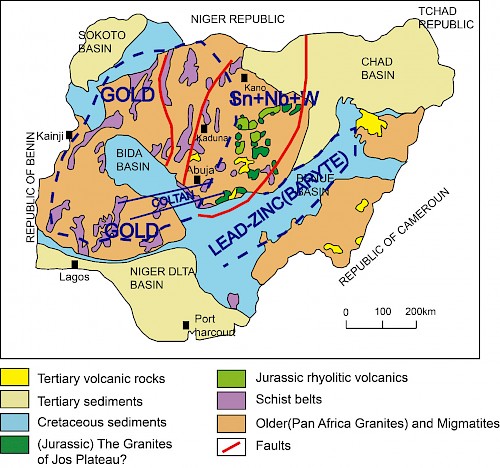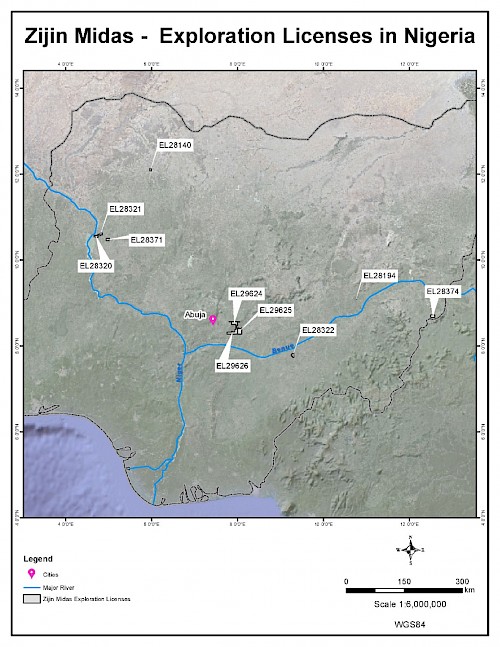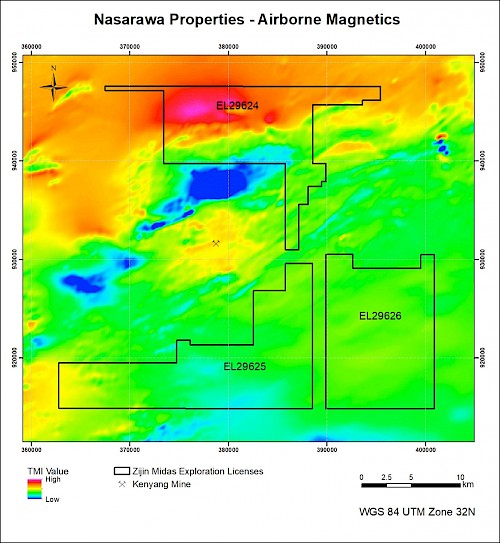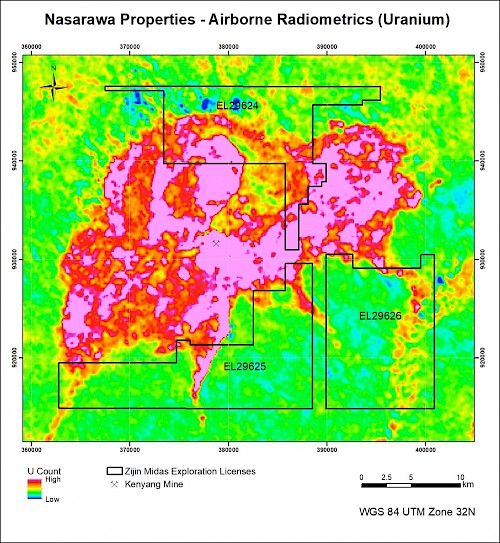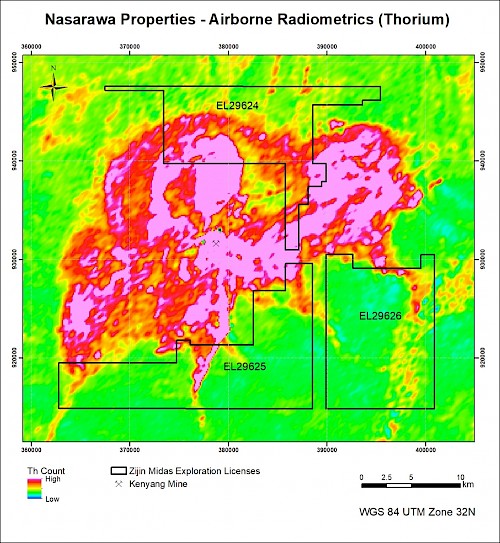Nigeria is situated within the Pan-African Mobile Belt and sandwiched between the West African Craton to the west and the Saharan Metacraton to the north and to the southeast. The geology of Nigeria was divided into three major petrological components – Precambrian Basement Complex (≥ 600 Ma), Jurassic Younger Granites (ca. 150 Ma), and Cretaceous to Recent Sedimentary Basins (≤ 145 Ma). The Precambrian Basement Complex can be further subdivided into three lithologic groups, including the migmatite gneiss complex, the schist belts and the Older Granites. The Old Granites as the main intrusive rocks in the Basement Complex are distributed all over the country, especially in the north and in the west; the Jurassic Younger Granites occur within a nearly N-S trending narrow belt in central Nigeria and extend northwards into Niger.
The four major metallogenic provinces in Nigeria are composed of Sn-Ta-Nb Pegmatite Belt of Late Pan-African age, Sn-Nb-Ta Younger Granites of Jurassic age, Pb-Zn Benue Trough of Cretaceous age, and Au Schist Belts of Precambrian ages. The Au Schist Belts and Sn-Ta-Nb Pegmatite Belt fall within the Complex Basement, and the mineral resource associated includes gold, silver, cassiterite, tantalite, columbite, banded iron formation, sillimanite, and gemstones. The province of Younger Granites is notable for its Sn-Nb-Ta mineralization, with other ore minerals of REE minerals, wolframite and accessory minerals of uraninite, thorite, and pyrochlore. In the Benue Trough of the Sedimentary Basins, N-S trending veins with galena, sphalerite, and sometimes chalcopyrite occur mostly at the crest of anticlines, where pockets of uranium occurrences have also been discovered.
Covering the central area of the Properties, the Kenyang Intrusive Complex regionally belongs to the Afu Complex, which is the southernmost occurrences of the Jurassic Younger Granites. The Kenyang Intrusive Complex consists of multiphase granites, including an early-phase pink coarse-grained K-feldspar biotite granite and a late-phase grey fine-grained biotite granite. The Nb-Ta mineralization occurs along the contact zone of two-phase intrusions and mainly exists in the endocontact of the late fine-grained granite with pervasive albitization.
Wildsky’s 3 exploration licenses in Nigeria
At the end of 2021, Company held 3 Nb-Ta exploration licenses (Nasarawa Nb-Ta property) in Nigeria, the total license area covered 474 square kilometers, on the central Nb-Ta mineralization belt in the middle of country.
Nasarawa Nb-Ta project
The Nasarawa Nb-Ta Project is located in Nasarawa State in central Nigeria, approximately 88 km southeast of Abuja, the capital city of Nigeria, and about 65 km west of the state capital Lafia. It is covered by three mineral claims, including EL 29624 (the Erigo Property), EL 29625 (the Udegi Property), and EL 29626 (the Akewa Property), with a total area of 47,400 hectares.
The Nasarawa Nb-Ta Project is located at the southern end of the Jurassic Younger Granites Lithological Province, which distinctively carries the Sn-Nb-Ta mineralization. The adjacent Kenyang Mine is only 7.5km away from Nasarawa property, Kengyang represents a typical LCT-granite-hosting Nb-Ta deposit, where primary Nb-Ta mineralization, characterized by disseminated columbite and tantalite, occurs in the endocontact of the roof zone of Jurassic fine-grained biotite granite along with pervasive albitization.
Wildsky completed a series of exploration activities in the second half of 2019 within the Nb-Ta Project area. The assay results from surface geochemical samples show that there is a strong positive correlation between Nb and radioactive elements U and Th. While columbite is a generally non-radioactive mineral, it always coexists with uraninite, thorite, monazite, and other U- or Th-bearing radioactive minerals. Accordingly, these radioactive minerals can serve as good vectors for the occurrence of associated Nb-Ta mineralization.
The geophysical surveys defined the contour of the contact between the late fine-grained granite and the early coarse-grained granite. Most of the geochemical samples with Nb over 100 ppm fall in the NEE-trending late fine-grained granite, and a few in the early coarse-grained granite stay close to the contact zone, which indicates that the Nb-Ta mineralization is controlled by the contact zones of two granitic intrusions, similar as what is observed in Kenyang Mine. Indicated the Nb-Ta Project presents great potential for the discovery of primary Nb-Ta mineralization, and so has sufficient merits to warrant further exploration and evaluation.
